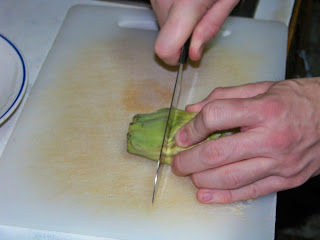Tortilla in Spain refers to something similar to an omelette. According to the Spanish Royal Academy, the institution responsible for regulating the Spanish language, the tortilla is a diminutive form of the word torta (a round cake). The tortilla is defined and translated as "a round-shaped, fried mixture of beaten eggs and one or various other ingredients." The most famous tortilla in Spain is the tortilla española (or tortilla de patatas) which is a simple omelette made of eggs, potatoes, olive oil and salt. These "Spanish omelettes" can also be filled with onions, peppers, chorizo, parsley, or various other ingredients. The most common is the potato omelette made either with or without onions. There are many other varieties of tortilla ranging from tuna or cod to zucchini or artichokes.
The artichoke is frequently used in Mediterranean cuisine in a wide variety of dishes. You can see it in its simplest form, used alone either boiled or fried, or mixed with other ingredients such as the tortilla that I am going to teach you to make today. I think the fresh artichoke may be a bit rare in many Midwestern American kitchens. I remember seeing its canned variety more than its fresh variety. In my opinion, the preserved variety is very tasteless and industrial. (I will save my ranting about using canned food for a later blog.) Artichokes are a fountain of nutrition. According to the United States Department of Agriculture, there are only 66 calories in each 100 grams of cooked, fresh artichokes. It is very low in fat and high in fiber, folate, and vitamins C&K. I always use fresh artichokes. At first they may seem difficult to cut with their bunch of thorny petals, but what lies beneath these hard, spiky petals is a delicious treasure.
Now, I will cut the chatter and get to the culinary instructions to help you uncover the hidden treasure that is the artichoke. I am sure that when you uncover it you will enjoy this authentic Spanish dish. ¡Buen provecho!
Equipment
- Frying pan
- Chopping board
- Spatula
- Plate
Ingredients
- 6 artichokes
- 4 - 5 eggs
- 2 cloves of garlic
- Olive oil
- Salt
Instructions
Take the outer petals off until you notice that the bottom part of the petals becomes a yellow-green color and the bottoms are no longer tough. After that, chop off the hard spiky tops of the petals and then cut the stem from the bottom. I divided each artichoke into eight pieces, but I think it would have been better to cut them into even smaller pieces. Then to finish with the artichokes I always put them in a bowl of water so they let out some of their dark color and do not change to brown.
Heat oil in pan over medium heat. Lightly crack the cloves of garlic with the flat part of the knife and peel off the skin. Fry the garlic on all sides until golden brown and remove it from the pan (this is supposed to give garlic flavor to the oil, but I don' know if it works so well).
Now add the artichokes and a pinch of salt. Cook them until they are softer, 7 - 8 minutes. Put them on a plate lined with paper towels to drain the oil a bit.
Heat a bit more oil in the frying pan. Beat the eggs well and add salt. Mix the cooked artichokes with the eggs. Add the mixture to the same frying pan and wait for the tortilla to start forming. When you see that it is quite done on the bottom, take a large plate and flip the omelette to cook the other side (this can be quite difficult sometimes). When the tortilla is finished on both sides it is ready.
Y ya está, it's finished! I recommend eating it as a starter with a bit of bread or as a side dish (or main dish) for breakfast, lunch or dinner. Whatever you do, please do not put ketchup on it!
















